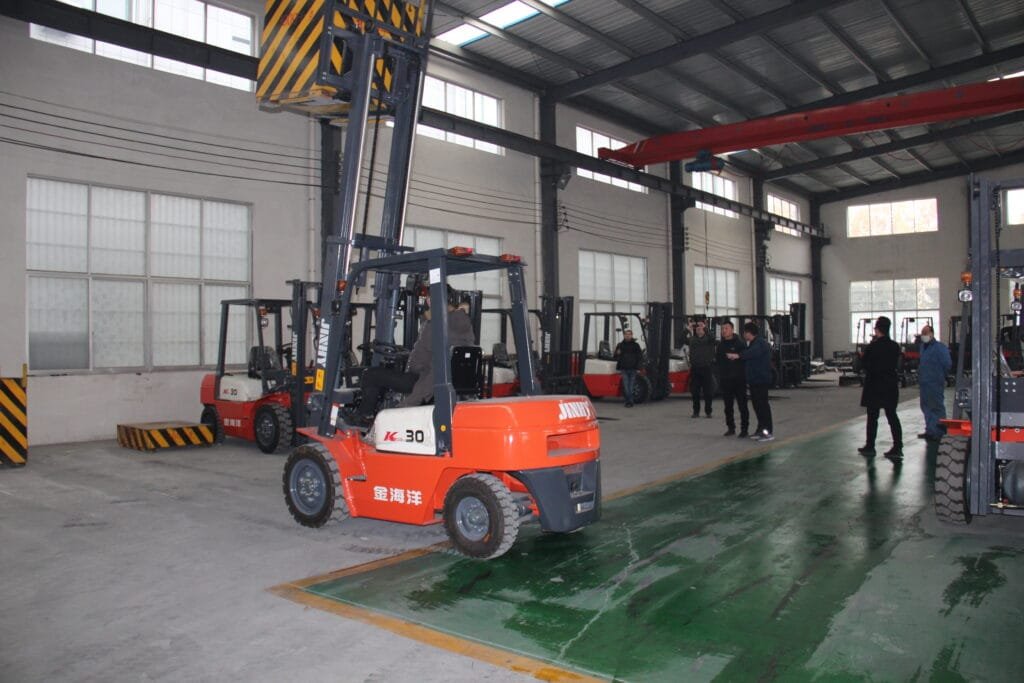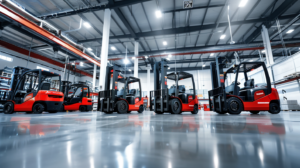Introduction to Shipping Electric Forklifts from China
China stands tall as the global powerhouse for electric forklift production, offering both affordability and innovation. As demand rises for clean-energy warehouse machinery, many international buyers seek to import electric forklifts directly from Chinese manufacturers. However, the process isn’t as simple as placing an order.
Shipping electric forklifts from China involves a series of technical, logistical, and legal considerations—from handling hazardous battery materials to ensuring customs compliance. This guide outlines every crucial step, ensuring your forklift shipment arrives safely, legally, and efficiently.

Understanding Electric Forklifts: Key Features & Export Popularity
What Makes Electric Forklifts Different from Traditional Models?
Electric forklifts use rechargeable batteries—mostly lithium-ion or lead-acid—instead of combustion engines. This provides a quieter, zero-emission solution ideal for indoor warehouses and clean-room operations.
Key Features:
- Zero emissions
- Low maintenance
- Battery-powered operation (up to 8-10 hours)
- Regenerative braking systems
These features make them increasingly popular in countries with strict emissions regulations.
Why China is a Global Hub for Electric Forklift Manufacturing
China’s dominance stems from:
- Scalable production capacity
- Competitive pricing
- Technological innovation (e.g., lithium battery integration)
- Global logistics infrastructure in cities like Shanghai and Shenzhen
Top Chinese brands meet international quality standards such as CE, UL, and ISO certifications, making them a reliable source for global buyers.
Pre-Shipment Considerations
Verifying Manufacturer Credentials and Certifications
Before placing an order, confirm the manufacturer is:
- Legally registered with a verified export license
- Certified for international standards (ISO9001, CE, etc.)
- Offering compliant batteries (UN38.3 certification required)
Use platforms like Made-in-China or Alibaba, but always request documentation and references.
Understanding Export-Ready Forklift Specifications
Double-check:
- Voltage compatibility
- Fork length, mast height, and load capacity
- Local adaptation (e.g., tire types, weather resistance)
Ensure all parts meet the import country’s operational standards.
Evaluating Legal & Regulatory Requirements in Importing Countries
Consult import laws regarding:
- Electric vehicles
- Lithium-ion battery transport
- Safety labeling
- Import duties and product testing
This ensures the forklift won’t get stuck at customs or rejected.

Battery Shipping Regulations and Safety Standards
Lithium-Ion Battery Hazards and Packaging Rules
Electric forklifts usually contain large lithium-ion batteries, which are considered Class 9 dangerous goods under international shipping laws. Mishandling them can lead to fires or leaks.
Packaging must include:
- Inner and outer non-conductive layers
- UN-certified boxes
- Thermal insulation
- Fireproof labeling
IATA and IMDG Code Compliance
If shipping by air or sea:
- IATA DGR (for air freight) and IMDG Code (for ocean freight) must be followed.
- Include a Material Safety Data Sheet (MSDS)
- Follow UN38.3 testing requirements for each battery pack
Safety Testing and Documentation for Battery Cargo
Required documentation includes:
- Battery test reports
- Dangerous Goods Declaration (DGD)
- Shipper’s Declaration for Dangerous Goods (for air freight)
Choosing the Right Freight Method for Shipping Forklifts
Sea Freight: FCL vs LCL for Heavy Equipment
FCL (Full Container Load) is ideal for single or multiple forklifts. Choose a 20ft or 40ft container based on weight.
LCL (Less than Container Load) is cheaper for small shipments, but forklifts may be exposed to more handling risks.
Air Freight Options for Urgent Shipments
Air freight is:
- Faster (4–10 days)
- Safer (if properly packed)
But:
- Extremely expensive for bulky items
- Restricted in battery weight and quantity
Only viable for smaller forklifts or parts.
Rail and Multimodal Transport Routes
Rail shipping from China to Europe (via Belt and Road Initiative) offers:
- Faster transit than sea (10–20 days)
- Lower costs than air
- Eco-friendlier options
Multimodal combines rail + truck for inland delivery.
Container Loading and Forklift Packaging Guidelines
Forklift Disassembly and Palletization Standards
For easier shipping and cost savings:
- Disassemble large components like forks and masts
- Use custom-built pallets or skids
- Secure with steel bands and shrink wrap
Proper disassembly can reduce dimensional weight and prevent mechanical damage during transit.
Weatherproofing and Shock-Proof Packaging Materials
Use materials like:
- Plastic film or tarpaulin for waterproofing
- Foam inserts for impact protection
- Moisture absorbent packets inside containers
Avoid cardboard-only packaging, especially for sea freight.
Using Wooden Crates vs Metal Containers
Wooden crates are:
- Cost-effective
- Easy to dispose of
But may not meet fumigation standards in some countries.
Metal containers provide:
- Stronger protection
- Fire resistance for battery transport
Best suited for high-value electric forklifts.

Customs Clearance and Documentation Requirements
Bill of Lading, Commercial Invoice, and Packing List
The core shipping documents:
- Bill of Lading – proves cargo ownership
- Commercial Invoice – shows product details and value
- Packing List – itemizes forklift parts, weights, and sizes
Make sure all values and HS codes are accurate to avoid customs issues.
Import Permits and Battery-Specific Declarations
Depending on the destination country, import permits may be needed for:
- Industrial machinery
- Hazardous goods (Class 9 batteries)
Always declare lithium batteries separately on the Dangerous Goods Form.
Certificates of Origin and Conformity
Most countries demand:
- Certificate of Origin – confirms Chinese manufacturing
- Conformity Certificates – proof of safety and emissions compliance (e.g., CE or RoHS)
Shipping Insurance for Electric Forklifts
Types of Coverage: All-Risk vs Named Perils
All-risk insurance covers:
- Theft
- Fire
- Water damage
- Mishandling
Named perils insurance only covers specified events. Always opt for all-risk when shipping high-value machinery.
Evaluating Policy Limits for Battery Components
Batteries are highly sensitive. Ensure your policy includes:
- High-value battery component coverage
- Risk of thermal runaway or explosion
- Coverage during all stages: loading, transit, unloading

Cost Breakdown and Budget Planning
Freight Charges, Customs Duties, and Handling Fees
Typical costs include:
- Sea freight (FCL): $2,000–$5,000
- Customs clearance: $300–$800
- Port handling: $150–$500
- Import tax: varies by country (5%–20%)
Unexpected Costs and Hidden Charges
Watch out for:
- Demurrage fees (container delays at port)
- Port surcharges
- Remote delivery zone fees
- Inspection or quarantine charges
Request a comprehensive quote from freight agents beforehand.
Common Challenges and How to Avoid Them
Delays Due to Hazardous Battery Declarations
Failing to properly declare batteries can cause:
- Cargo rejection
- Delays
- Heavy fines
Solution: Work with freight forwarders experienced in battery logistics.
Damaged Goods and Improper Packing Risks
Improper crating leads to:
- Component breakage
- Internal battery damage
Solution: Use vibration-tested packaging and industrial-grade pallets.
Mismatched Documentation Issues
Errors in invoices or HS codes can:
- Trigger customs audits
- Cause cargo seizure
Solution: Triple-check all paperwork and hire a customs broker if needed.

Tips for Working with Chinese Freight Forwarders
Choosing Reputable Logistics Partners
Look for:
- Years of experience with forklifts
- Knowledge of lithium battery regulations
- Transparent pricing
Platforms like Freightos or Alibaba Logistics can connect you with verified partners.
Importance of Dual Communication and Progress Updates
Establish:
- Weekly shipment status updates
- Clear escalation points
- Access to tracking platforms
Good communication minimizes delays and surprises.
Post-Arrival Steps and Local Transportation
Unloading and Handling Precautions
Forklifts must be:
- Unloaded with cranes or forklifts rated above their weight
- Checked for transport damage
- Stored in dry, safe warehouses
Never connect or charge batteries until inspection is complete.
Final Delivery and Setup at Destination
After customs clearance:
- Arrange for insured ground transportation
- Reassemble forklift (if disassembled)
- Charge and test battery before use
Keep all manuals and certifications handy for regulatory inspections.
Sustainability and Environmental Considerations
Recycling Packaging and Battery Disposal Regulations
Many countries require:
- Proper recycling of wood and plastic packaging
- Safe disposal of used lithium-ion batteries
Partner with local recycling agencies for battery waste compliance.
Emission Reduction and Eco-Friendly Shipping Practices
Sustainable options:
- Use carbon-offset freight programs
- Choose ocean freight over air
- Optimize container space with efficient packaging

FAQs About Shipping Electric Forklifts from China
1. Can I ship an electric forklift with the battery installed?
Yes, but it must be declared as hazardous cargo and meet all lithium battery packaging and documentation rules.
2. What Incoterm should I use for forklift shipping?
FOB (Free on Board) is common. It covers costs until the goods are loaded on the ship. DDP (Delivered Duty Paid) is more convenient but more expensive.
3. How long does sea freight take from China?
It ranges from 20 to 45 days depending on the destination port and shipping method.
4. Do I need a license to import an electric forklift?
Yes, in most countries. Check with your national trade authority or customs office.
5. Can I ship multiple forklifts in one container?
Yes. With proper disassembly, up to two standard electric forklifts can fit in a 40-foot container.
6. What’s the best port in China for forklift exports?
Shanghai, Ningbo, and Shenzhen are major ports with robust machinery export facilities.
Conclusion: Best Practices for Smooth Forklift Shipments
Shipping electric forklifts from China may sound complicated, but with proper planning, it can be seamless and cost-effective. From understanding lithium battery laws to choosing the right freight method and preparing documentation, every step matters.
Working with reliable manufacturers, logistics experts, and customs brokers is the key to successful delivery. Always prioritize safety, regulatory compliance, and open communication throughout the shipping journey.
Whether you’re importing a single unit or a fleet of forklifts, following these expert guidelines will ensure your shipment arrives on time, intact, and ready to go to work.




